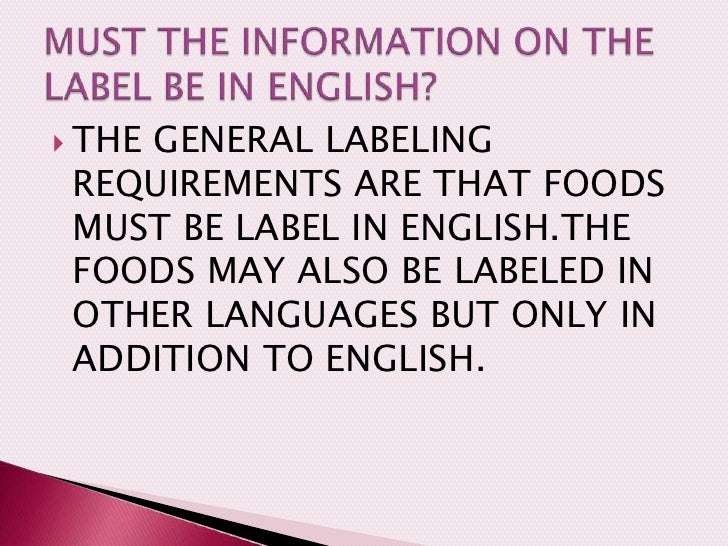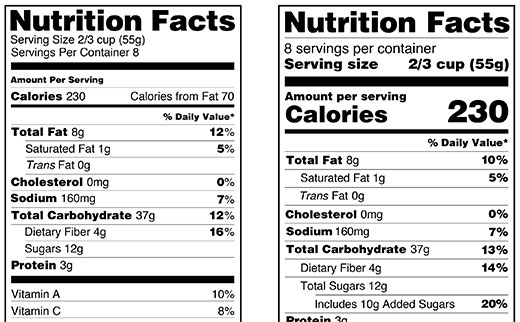39 understanding food labels uk
Food labelling - get into the habit of checking the label Look for five key points on the label: 1. Energy The terms 'kJ' and 'kcal' (calories) tell you how much energy is in a product. Women need an average of 2,000 kcal a day and men need 2,500 kcal on average. 2. Saturates Saturates is another word for saturated fat. This section tells you about the amount of saturated fat in the product. 3. Salt FREE! - Understanding Food Labeling PowerPoint - Twinkl This PowerPoint helps explain the basics of food labeling in the UK. It encourages children to think about why the information on food labels is important and how people can use it to make healthy choices! Tags in this resource: food-label-traffic-light-system.pngnutrition-label.pngPacket-of-Cupcakes.pngpacket-of-crisps.pngboy-thinking-1.pngBoy-Eating-Breakfast-2.png
PDF Understanding food labels Understanding food labels that understanding how to read food labels is important. 1. Nutrition labels can help you: y Compare products/brands y Check how much fat, sugar or salt is in a food y corn syrup, sucrose, dextrose, glucose, maltose and Choose the healthiest option y Check the ingredients y Understand what a typical portion size is 2. What am I looking for? 3.

Understanding food labels uk
Understanding UK food labels - Weightplan.com Understanding UK food labels: Understanding food labels is really important when you are choosing pre-packaged foods, or drinks. Reading the labels means that you can make a better informed choice about the foods you are buying. This will help you to decide if the produce is a 'healthier choice'. PDF Understanding of Food Labelling Terms - Food Standards Agency Understanding of Food Labelling Terms Used to Indicate the Absence or Reduction of Lactose, Milk or Dairy 5 Executive Summary Background and Research Method This research was commissioned by the... How to Understand food labels - Practical tips and advice - ClaireG PT Here are some tips for understanding how food labeling works and I would recommend printing out a Food Label Decoder (as seen below) to keep in your purse/wallet to use when you go shopping. Food Label Decoder Ingredients lists Most pre-packaged foods have an ingredients list on the back of the packet.
Understanding food labels uk. Understanding Food Labels - YouTube In a tizz about food labels? Let Sophie and Paul explain how to decipher common food labelling to help you make healthier choices! How to read a nutrition label - The Food Medic Summary. Reading food labels isn't in everyone's best interest. But if this feels useful for you, some of the most helpful things to look out for on food labels include: The traffic light labels (if there is one on the front of the packet). The per 100g/ml or per portion nutrition information on the back of the packet. Food labelling - what you need to know | Health | Bupa UK Food labelling laws mean that food manufacturers and retailers are legally obliged to put the following information on their labels. A list of ingredients, starting off with the one that the product contains the most of. The weight or volume of the product. The name of the food - including a description for brand names. Understanding Food Labels | Ignite | Brother UK Currently labels typically include use-by date, origin of product, allergens, quantity, barcode, name of food, ingredients, nutritional value, name and address of the manufacturer, packer or seller, storage conditions and, if relevant, cooking instructions. Food label issues
How to Read Food Labels | Institute of Health Sciences Learning how to read food labels helps to keep a check on the amount of foods you're eating that are high in fat, salt and added sugars. Do you struggle to understand: Nutrition labels on the back or side of packaging Nutrition labels on the front of packaging Reference intake (RI) Red, amber and green colour-coding Ingredients list Looking at labels - British Nutrition Foundation Food labels provide a lot of useful information about what foods and drinks contain, provided you know where to find the information you're looking for. The laws around food labelling in the UK have largely been retained from European Union (EU) legislation on the provision of food information to consumers. Understanding food labelling in Great Britain 2003-2017 | Statista This statistic shows a trend in British consumers who find it difficult to understand food labelling in Great Britain. The data is taken from surveys conducted biennially from 2003 to 2017, which... How to understand Nutrition food labels (EU/UK) — Gemma Sampson Here enters the need for nutrition labels, and some code to decipher what they mean: Energy. Energy free - less than 4kcal (17kJ) per 100ml. Reduced energy - at least a 30% reduction from the original product/compared product. Low energy - less than 40kcal (170kJ) per 100g for solids OR <20kcal (80kJ) per 100ml for liquids. Total Fat
How to Read Food Labels | Nutrition | Holland & Barrett You'll usually find a nutrition label on the front of packaging giving a quick guide to: Energy Fat Saturated fat Sugars Salt This tells you the number of grams of fat, saturated fat, sugars and salt in the product, and the amount of energy (in kJ and Kcal) it contains. A detailed approach Understanding Food Labels Guide | World Cancer Research Fund UK Our guide explains the terms used on food labels including serving size, nutrients, reference intakes and traffic light labels. We also help you to understand health claims made on food labels such as 'no added sugar', 'reduced fat' and 'low fat'. Understanding food and drink labels can be a great first step towards making healthier choices when shopping. Download Order a free printed copy 10 tips for understanding food labels - Heart Matters magazine Supermarket shelves are full of foods and drinks, many of them making claims that sound healthy. Hannah Elliott explains how to use back-of-pack food labels to make healthy choices. Food labelling can help us make an informed decision when shopping, but understanding the labels can feel difficult. While colour-coded front-of-pack labelling is a simple way to decode a nutrition label, not all manufacturers use this system. Food labelling and packaging: Overview - GOV.UK Food labelling - what you must show Ingredients list Food and drink warnings Nutrition, health claims and supplement labelling Organic food Overview To sell food and drink products, the label must...

UNDERSTANDING FOOD LABELS - MAKE THE BEST FOOD DECISIONS | Nutrition labels, Nutrition, Reading ...
Understanding food labels - Blood Pressure UK What do nutrition labels tell you? Most packaged foods are required by law to carry nutritional ...
Understanding Food Labels - Norfolk and Norwich University Hospitals ... Understanding Food Labels The label may also provide information about the type of fat. There are 3 main types listed: saturates, polyunsaturates and monounsaturates. Saturated is the type of fat associated with an increased risk of heart disease and other circulation problems. Low-fat biscuits, cakes and desserts are often high in sugar.
Understanding food labels - Livewell It's important to understand energy values on food labels. Many products will list the calories on the front of the pack, along with further key information such as fat (and saturated fat), sugar, and salt. Food labels will almost always display energy values in kilojoules ("KJ") and kilocalories ("kcal", usually referred to as "calories").
Understanding Food Labelling - Kellogg's Nutrition Healthcare Professionals Food labels contain a wealth of useful information for consumers, provided they understand what the information conveys and how it can help to build a healthy balanced diet. In the UK and across Europe, the information that appears on food labels is carefully controlled in order to help consumers understand the key attributes of the foods that they are buying.
Understanding food labels | Diabetes UK The traffic light system for 'front of pack' labelling, while still voluntary, has been around for a while now and is an easy way to check at a glance how healthy a food is. The labels show how many calories are in the food or drink and are also colour coded to show whether the food is low (green), medium (amber) or high (red) in fat, saturated fat, sugar and salt.
Food labels too complicated for most shoppers to understand - new research In the UK, the Food Standards Agency regulates the use of food ... but understanding the labels can feel difficult. ... Effective legislation for food labels is a challenge because it needs to ...
PDF Food and drink labelling - Food label they need to adapt to the new food labels and use them with confidence'. 1. The regulation's full name is the 'EU Regulation 1169/2011 on the provision of food information to consumers' Labels on pre-packaged food and drinks have changed due to a new European Regulation1. This new piece of legislation is designed to make food labelling ...
Understanding Food Label Regulations - METTLER TOLEDO Understanding Food Label Regulations This paper gives an overview of labeling regulations and requirements for the US, Canada, EU, UK, and Chinese markets. It has a new featured section on UK food labeling standards adapted because of departure from the EU.
Food labels - NHS These labels provide information on the number of grams of fat, saturated fat, sugars and salt, and the amount of energy (in kJ and kcal) in a serving or portion of the food. But be aware that the manufacturer's idea of a portion may be different from yours. Some front-of-pack nutrition labels also provide information about reference intakes.
Labelling | Food Standards Agency Nutrition labelling It is mandatory for nutrition information to be declared on prepacked food. In Northern Ireland, the FSA is responsible for nutrition labelling. District Councils enforce these...
How to Understand food labels - Practical tips and advice - ClaireG PT Here are some tips for understanding how food labeling works and I would recommend printing out a Food Label Decoder (as seen below) to keep in your purse/wallet to use when you go shopping. Food Label Decoder Ingredients lists Most pre-packaged foods have an ingredients list on the back of the packet.
PDF Understanding of Food Labelling Terms - Food Standards Agency Understanding of Food Labelling Terms Used to Indicate the Absence or Reduction of Lactose, Milk or Dairy 5 Executive Summary Background and Research Method This research was commissioned by the...
Understanding UK food labels - Weightplan.com Understanding UK food labels: Understanding food labels is really important when you are choosing pre-packaged foods, or drinks. Reading the labels means that you can make a better informed choice about the foods you are buying. This will help you to decide if the produce is a 'healthier choice'.




/arc-anglerfish-tgam-prod-tgam.s3.amazonaws.com/public/4B6P5XQ4SJHLXJZL37YFCY2FQQ)






Post a Comment for "39 understanding food labels uk"